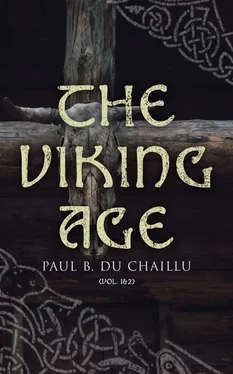“Bödmód, the son of Framar, after inviting Ketil to his hall, mentioned Odin. When he named Odin, Ketil got angry, for he did not believe in him; and sung a song:—
Odin worship
Did I never,
Though long I have lived;
I know that Framar
Will fall sooner than
This high head.
Twice the sword of Ketil did not bite; the third time it cut Framar from the shoulder down to the loins. Then Framar sung:—
There is courage in Hæng,
Dravendil is sharp,
It bit the word of Odin
As if it were nothing;
Now the father of Baldr proved false
It is unsafe to trust him;
Enjoy well thy hands,
Here we shall part.
Framar thereupon died, and Ketil went home” (Ketil Hæng’s Saga, c. 5).
CHAPTER XXI.
RELIGION.—ALTARS, TEMPLES, HIGH-SEAT PILLARS, ETC.
Table of Contents
The most primitive form of altar—The earliest Asa temple in the North—The temples in Norway and Denmark—Size and materials of temples—Their magnificence—Temple priests—Support of temple—Holiness and sacredness of temples—High-seat pillars—Sacred pegs.
The hörg was a sacred altar, built of stones, often mentioned in the Eddas and Sagas, but never described, and was quite distinct from the stalli , or altar. Perhaps it was an enclosed structure, or was built over a sacrificing mound or upon some elevation. Its primitive form makes it undoubtedly of far greater antiquity than the temple, though both were retained as we see in later times by the people in their worship. It seems to have been especially used for sacrifices to the Alfar and Asar; 242and from the words of Freyja to Hyndla, who was her friend, when speaking of Ottar, we find that a hörg had been raised to her by the latter, and sacrifices made to her.
He made me a hörg
Reared of stones;
Now have these stones
Become gler . 243
He reddened it in
Fresh ox blood.
Ottar believed
Always in Asynjur.
[Hyndluljód, st. 10.]
The first temple belonging to the Asa creed which Odin is fabled to have established was at Sigtuna; afterwards the most celebrated of all the temples in the North was that of Upsala, but unfortunately we have no description of it in the Sagas; its fame was so great that on special occasions people from all over the North came to it.
The two principal temples in Norway were in Hladir in Thrandheim, and in Gudbrandsdal.
“Gudbrand of Dalir was a great friend of Hakon Jarl. They owned a temple which was the second for size in Norway, the largest being at Hladir (in Thrandheim). The former was never unlocked except when the Jarl came thither” (Njala, 87).
The largest one in Denmark was in Hleidra (Zeeland), but unfortunately in this case also the Sagas give no description. Other temples of less repute were also built.
The Hof or temple was often of large size, and the Sagas give us examples of their appearance, some of them being of great splendour; they were generally if not always rectangular buildings, 244with a rounded addition at one end like the apse of a church. Some had two parts: an inner or more sacred one, where the images of the gods were placed; and an outer one, where the sacrificial feasts were held. At the blotveitsla or sacrificial feast the people seem to have remained standing, high seats existing only for the blotgodi (sacrificing priest). At the farther end the God (god-idols) stood on their stall (altar).
“Olaf sailed to Hladir, and had the temple broken down, and all the property and ornaments taken out of it and off the gods. He took a large gold ring from the temple door, which Hakon Jarl had made, and then had the temple burnt.
“Olaf sent the large gold ring which he had taken from the temple door to Queen Sigrid, Storrada (the Proud) in Sweden (he wanted to marry her). She had it broken, and brass was found inside. She got angry, and said that Olaf was likely to be false in more things than this” (Olaf Tryggvason, 65, 66).
Sometimes these buildings were magnificently furnished and adorned with costly and precious metals; their walls were hung with tapestries, and otherwise ornamented, 245and on the door was a golden ring. 246Many of them must have been the property of powerful and wealthy bœndr, 247as may be inferred from the fact that some chiefs when they left the country tore them down and took them away, together with the temple mould on which they stood, which was holy.
“Ketilbjörn, a famous man in Norway, went to Iceland, and dwelt at Mosfell. He was so rich in personal property that he told his sons to make a cross-beam of silver in the temple which they were building. As they would not, he with his thrall Haki and his bondmaid Bót drove the silver up on the mountain with two oxen; they hid it so that it has never been found since; then he killed Haki in Hakaskard, and Bót in Bótarskard” (Landnama v. 12).
“Thorhad the old was temple-priest in Thrandheim, in Mœri. He wished to go to Iceland, but first took down the temple, and carried with him the temple mould and the altars. He came into Stödvar-fjord and made the whole fiord as holy as the temple place in Mœri, and allowed nothing to be slain there except homestead cattle. He lived there all his life afterwards; the Stodfirdings are descended from him” 248(Landnama).
The hof-godi or temple-priest was occasionally a woman.
“Steinvör was a priestess, and took care of the head temple; to this all bœndr had to pay temple tax. Steinvör went to the chief Broddhelgi, for she was related to him, and told him her trouble, that Thorleif, the Christian, did not pay temple tax like other men. Broddhelgi said he would take up this case for her against Thorleif.” 249
A tax, as we have seen, was said to have been imposed in Odin’s time for the support of the temple; in the time of Frey a change took place, according to the sagas, and certain lands and properties in the several districts called Uppsala-Aud (Uppsala wealth) were set apart for this purpose; but in later times again, in Norway at least, and probably in other parts of the North, the bœndr had to pay taxes for the support of the temples, some of which seem to have been the private property of the godi.
The temples were considered so holy that any one damaging them or entering them armed was declared an outlaw, and no one who had committed an offence punishable by law was allowed to enter; such person was called Varg i Veum (wolf in the sanctuary). The grove or fields surrounding the temples were often regarded as inviolate, so that no act of violence would be permissible within their precincts. This was expressed by the ancient name of Ve (sanctuary, sacred place), which was extended so as to embrace the Thing -place, which was also regarded as sacred, while the Thing was going on.
“Ingimund went into the temple, and before he was aware of it Rafn ran in with a sword. Ingimund turned towards him and said, ‘It is not the custom to bring weapons into the temple, and thou wilt turn the wrath of the gods against thee; such a thing is impossible unless it is atoned for’ ” (Vatnsdœla, c. 17).
“Búi went to the temple, and when he arrived there, saw that the enclosure as well as the temple was unlocked. He entered and perceived that Thorstein lay on his face in front of Thor. Búi walked silently until he came to Thorstein, and grasped his knees with one hand and his shoulders with the other in such a manner that he lifted him and struck his head so hard against a stone that his brains were scattered over the floor; he died immediately. Búi carried him out and threw him near the fence of the enclosure, and entered the temple again. He took the sacred fire, and, kindling lights, carried them around the temple and set the hangings on fire. The fire quickly caught one thing after the other, and in a short time the temple was in flames. He went out and locked both the temple and the enclosure, and threw the keys into the fire and departed. Thorgrim Godi awoke in the morning and saw the temple burning; he called on his people, men and women, to run with water vessels and save it; he also called upon his son, Thorstein, but he was nowhere to be found. When they reached the gate of the enclosure it was not easy to pass, for it was locked, and the keys were nowhere to be found; they were obliged to break open the door, for the fence was so high that they could not get over it. Entering the enclosure, they saw Thorstein there dead; the temple was also locked, and nothing in it could be saved. Hooks were brought and the temple was pulled down, and thus part of the temple was saved” (Kjalnesinga Saga, c. 4).
Читать дальше












